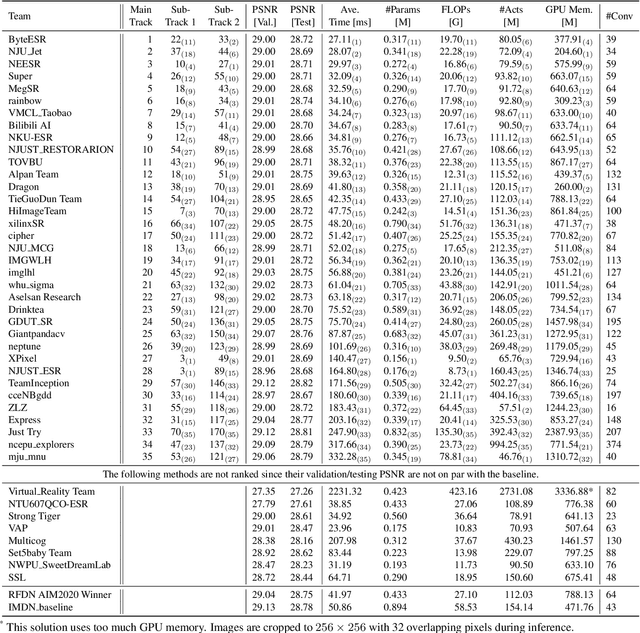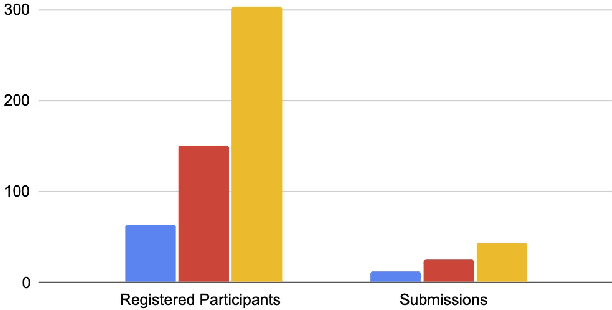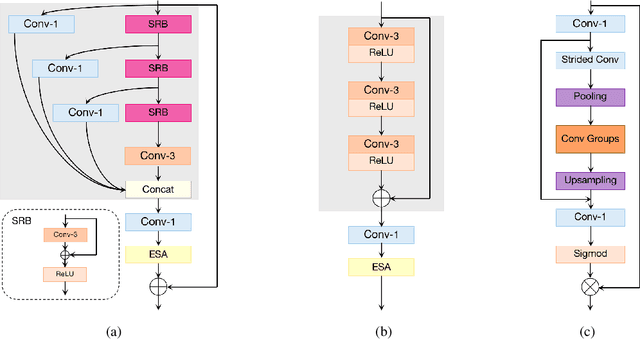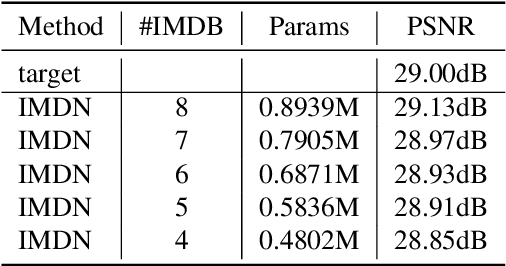Xiaozhong Ji
Align and Surpass Human Camouflaged Perception: Visual Refocus Reinforcement Fine-Tuning
May 26, 2025Abstract:Current multi-modal models exhibit a notable misalignment with the human visual system when identifying objects that are visually assimilated into the background. Our observations reveal that these multi-modal models cannot distinguish concealed objects, demonstrating an inability to emulate human cognitive processes which effectively utilize foreground-background similarity principles for visual analysis. To analyze this hidden human-model visual thinking discrepancy, we build a visual system that mimicks human visual camouflaged perception to progressively and iteratively `refocus' visual concealed content. The refocus is a progressive guidance mechanism enabling models to logically localize objects in visual images through stepwise reasoning. The localization process of concealed objects requires hierarchical attention shifting with dynamic adjustment and refinement of prior cognitive knowledge. In this paper, we propose a visual refocus reinforcement framework via the policy optimization algorithm to encourage multi-modal models to think and refocus more before answering, and achieve excellent reasoning abilities to align and even surpass human camouflaged perception systems. Our extensive experiments on camouflaged perception successfully demonstrate the emergence of refocus visual phenomena, characterized by multiple reasoning tokens and dynamic adjustment of the detection box. Besides, experimental results on both camouflaged object classification and detection tasks exhibit significantly superior performance compared to Supervised Fine-Tuning (SFT) baselines.
Disentangle Identity, Cooperate Emotion: Correlation-Aware Emotional Talking Portrait Generation
Apr 25, 2025Abstract:Recent advances in Talking Head Generation (THG) have achieved impressive lip synchronization and visual quality through diffusion models; yet existing methods struggle to generate emotionally expressive portraits while preserving speaker identity. We identify three critical limitations in current emotional talking head generation: insufficient utilization of audio's inherent emotional cues, identity leakage in emotion representations, and isolated learning of emotion correlations. To address these challenges, we propose a novel framework dubbed as DICE-Talk, following the idea of disentangling identity with emotion, and then cooperating emotions with similar characteristics. First, we develop a disentangled emotion embedder that jointly models audio-visual emotional cues through cross-modal attention, representing emotions as identity-agnostic Gaussian distributions. Second, we introduce a correlation-enhanced emotion conditioning module with learnable Emotion Banks that explicitly capture inter-emotion relationships through vector quantization and attention-based feature aggregation. Third, we design an emotion discrimination objective that enforces affective consistency during the diffusion process through latent-space classification. Extensive experiments on MEAD and HDTF datasets demonstrate our method's superiority, outperforming state-of-the-art approaches in emotion accuracy while maintaining competitive lip-sync performance. Qualitative results and user studies further confirm our method's ability to generate identity-preserving portraits with rich, correlated emotional expressions that naturally adapt to unseen identities.
HunyuanPortrait: Implicit Condition Control for Enhanced Portrait Animation
Mar 25, 2025Abstract:We introduce HunyuanPortrait, a diffusion-based condition control method that employs implicit representations for highly controllable and lifelike portrait animation. Given a single portrait image as an appearance reference and video clips as driving templates, HunyuanPortrait can animate the character in the reference image by the facial expression and head pose of the driving videos. In our framework, we utilize pre-trained encoders to achieve the decoupling of portrait motion information and identity in videos. To do so, implicit representation is adopted to encode motion information and is employed as control signals in the animation phase. By leveraging the power of stable video diffusion as the main building block, we carefully design adapter layers to inject control signals into the denoising unet through attention mechanisms. These bring spatial richness of details and temporal consistency. HunyuanPortrait also exhibits strong generalization performance, which can effectively disentangle appearance and motion under different image styles. Our framework outperforms existing methods, demonstrating superior temporal consistency and controllability. Our project is available at https://kkakkkka.github.io/HunyuanPortrait.
Sonic: Shifting Focus to Global Audio Perception in Portrait Animation
Nov 25, 2024



Abstract:The study of talking face generation mainly explores the intricacies of synchronizing facial movements and crafting visually appealing, temporally-coherent animations. However, due to the limited exploration of global audio perception, current approaches predominantly employ auxiliary visual and spatial knowledge to stabilize the movements, which often results in the deterioration of the naturalness and temporal inconsistencies.Considering the essence of audio-driven animation, the audio signal serves as the ideal and unique priors to adjust facial expressions and lip movements, without resorting to interference of any visual signals. Based on this motivation, we propose a novel paradigm, dubbed as Sonic, to {s}hift f{o}cus on the exploration of global audio per{c}ept{i}o{n}.To effectively leverage global audio knowledge, we disentangle it into intra- and inter-clip audio perception and collaborate with both aspects to enhance overall perception.For the intra-clip audio perception, 1). \textbf{Context-enhanced audio learning}, in which long-range intra-clip temporal audio knowledge is extracted to provide facial expression and lip motion priors implicitly expressed as the tone and speed of speech. 2). \textbf{Motion-decoupled controller}, in which the motion of the head and expression movement are disentangled and independently controlled by intra-audio clips. Most importantly, for inter-clip audio perception, as a bridge to connect the intra-clips to achieve the global perception, \textbf{Time-aware position shift fusion}, in which the global inter-clip audio information is considered and fused for long-audio inference via through consecutively time-aware shifted windows. Extensive experiments demonstrate that the novel audio-driven paradigm outperform existing SOTA methodologies in terms of video quality, temporally consistency, lip synchronization precision, and motion diversity.
SVP: Style-Enhanced Vivid Portrait Talking Head Diffusion Model
Sep 05, 2024Abstract:Talking Head Generation (THG), typically driven by audio, is an important and challenging task with broad application prospects in various fields such as digital humans, film production, and virtual reality. While diffusion model-based THG methods present high quality and stable content generation, they often overlook the intrinsic style which encompasses personalized features such as speaking habits and facial expressions of a video. As consequence, the generated video content lacks diversity and vividness, thus being limited in real life scenarios. To address these issues, we propose a novel framework named Style-Enhanced Vivid Portrait (SVP) which fully leverages style-related information in THG. Specifically, we first introduce the novel probabilistic style prior learning to model the intrinsic style as a Gaussian distribution using facial expressions and audio embedding. The distribution is learned through the 'bespoked' contrastive objective, effectively capturing the dynamic style information in each video. Then we finetune a pretrained Stable Diffusion (SD) model to inject the learned intrinsic style as a controlling signal via cross attention. Experiments show that our model generates diverse, vivid, and high-quality videos with flexible control over intrinsic styles, outperforming existing state-of-the-art methods.
RealTalk: Real-time and Realistic Audio-driven Face Generation with 3D Facial Prior-guided Identity Alignment Network
Jun 26, 2024Abstract:Person-generic audio-driven face generation is a challenging task in computer vision. Previous methods have achieved remarkable progress in audio-visual synchronization, but there is still a significant gap between current results and practical applications. The challenges are two-fold: 1) Preserving unique individual traits for achieving high-precision lip synchronization. 2) Generating high-quality facial renderings in real-time performance. In this paper, we propose a novel generalized audio-driven framework RealTalk, which consists of an audio-to-expression transformer and a high-fidelity expression-to-face renderer. In the first component, we consider both identity and intra-personal variation features related to speaking lip movements. By incorporating cross-modal attention on the enriched facial priors, we can effectively align lip movements with audio, thus attaining greater precision in expression prediction. In the second component, we design a lightweight facial identity alignment (FIA) module which includes a lip-shape control structure and a face texture reference structure. This novel design allows us to generate fine details in real-time, without depending on sophisticated and inefficient feature alignment modules. Our experimental results, both quantitative and qualitative, on public datasets demonstrate the clear advantages of our method in terms of lip-speech synchronization and generation quality. Furthermore, our method is efficient and requires fewer computational resources, making it well-suited to meet the needs of practical applications.
DiffuMatting: Synthesizing Arbitrary Objects with Matting-level Annotation
Mar 10, 2024Abstract:Due to the difficulty and labor-consuming nature of getting highly accurate or matting annotations, there only exists a limited amount of highly accurate labels available to the public. To tackle this challenge, we propose a DiffuMatting which inherits the strong Everything generation ability of diffusion and endows the power of "matting anything". Our DiffuMatting can 1). act as an anything matting factory with high accurate annotations 2). be well-compatible with community LoRAs or various conditional control approaches to achieve the community-friendly art design and controllable generation. Specifically, inspired by green-screen-matting, we aim to teach the diffusion model to paint on a fixed green screen canvas. To this end, a large-scale greenscreen dataset (Green100K) is collected as a training dataset for DiffuMatting. Secondly, a green background control loss is proposed to keep the drawing board as a pure green color to distinguish the foreground and background. To ensure the synthesized object has more edge details, a detailed-enhancement of transition boundary loss is proposed as a guideline to generate objects with more complicated edge structures. Aiming to simultaneously generate the object and its matting annotation, we build a matting head to make a green color removal in the latent space of the VAE decoder. Our DiffuMatting shows several potential applications (e.g., matting-data generator, community-friendly art design and controllable generation). As a matting-data generator, DiffuMatting synthesizes general object and portrait matting sets, effectively reducing the relative MSE error by 15.4% in General Object Matting and 11.4% in Portrait Matting tasks.
UniM-OV3D: Uni-Modality Open-Vocabulary 3D Scene Understanding with Fine-Grained Feature Representation
Jan 31, 2024



Abstract:3D open-vocabulary scene understanding aims to recognize arbitrary novel categories beyond the base label space. However, existing works not only fail to fully utilize all the available modal information in the 3D domain but also lack sufficient granularity in representing the features of each modality. In this paper, we propose a unified multimodal 3D open-vocabulary scene understanding network, namely UniM-OV3D, which aligns point clouds with image, language and depth. To better integrate global and local features of the point clouds, we design a hierarchical point cloud feature extraction module that learns comprehensive fine-grained feature representations. Further, to facilitate the learning of coarse-to-fine point-semantic representations from captions, we propose the utilization of hierarchical 3D caption pairs, capitalizing on geometric constraints across various viewpoints of 3D scenes. Extensive experimental results demonstrate the effectiveness and superiority of our method in open-vocabulary semantic and instance segmentation, which achieves state-of-the-art performance on both indoor and outdoor benchmarks such as ScanNet, ScanNet200, S3IDS and nuScenes. Code is available at https://github.com/hithqd/UniM-OV3D.
NTIRE 2022 Challenge on Efficient Super-Resolution: Methods and Results
May 11, 2022



Abstract:This paper reviews the NTIRE 2022 challenge on efficient single image super-resolution with focus on the proposed solutions and results. The task of the challenge was to super-resolve an input image with a magnification factor of $\times$4 based on pairs of low and corresponding high resolution images. The aim was to design a network for single image super-resolution that achieved improvement of efficiency measured according to several metrics including runtime, parameters, FLOPs, activations, and memory consumption while at least maintaining the PSNR of 29.00dB on DIV2K validation set. IMDN is set as the baseline for efficiency measurement. The challenge had 3 tracks including the main track (runtime), sub-track one (model complexity), and sub-track two (overall performance). In the main track, the practical runtime performance of the submissions was evaluated. The rank of the teams were determined directly by the absolute value of the average runtime on the validation set and test set. In sub-track one, the number of parameters and FLOPs were considered. And the individual rankings of the two metrics were summed up to determine a final ranking in this track. In sub-track two, all of the five metrics mentioned in the description of the challenge including runtime, parameter count, FLOPs, activations, and memory consumption were considered. Similar to sub-track one, the rankings of five metrics were summed up to determine a final ranking. The challenge had 303 registered participants, and 43 teams made valid submissions. They gauge the state-of-the-art in efficient single image super-resolution.
Spectrum-to-Kernel Translation for Accurate Blind Image Super-Resolution
Oct 23, 2021



Abstract:Deep-learning based Super-Resolution (SR) methods have exhibited promising performance under non-blind setting where blur kernel is known. However, blur kernels of Low-Resolution (LR) images in different practical applications are usually unknown. It may lead to significant performance drop when degradation process of training images deviates from that of real images. In this paper, we propose a novel blind SR framework to super-resolve LR images degraded by arbitrary blur kernel with accurate kernel estimation in frequency domain. To our best knowledge, this is the first deep learning method which conducts blur kernel estimation in frequency domain. Specifically, we first demonstrate that feature representation in frequency domain is more conducive for blur kernel reconstruction than in spatial domain. Next, we present a Spectrum-to-Kernel (S$2$K) network to estimate general blur kernels in diverse forms. We use a Conditional GAN (CGAN) combined with SR-oriented optimization target to learn the end-to-end translation from degraded images' spectra to unknown kernels. Extensive experiments on both synthetic and real-world images demonstrate that our proposed method sufficiently reduces blur kernel estimation error, thus enables the off-the-shelf non-blind SR methods to work under blind setting effectively, and achieves superior performance over state-of-the-art blind SR methods, averagely by 1.39dB, 0.48dB on commom blind SR setting (with Gaussian kernels) for scales $2\times$ and $4\times$, respectively.
 Add to Chrome
Add to Chrome Add to Firefox
Add to Firefox Add to Edge
Add to Edge